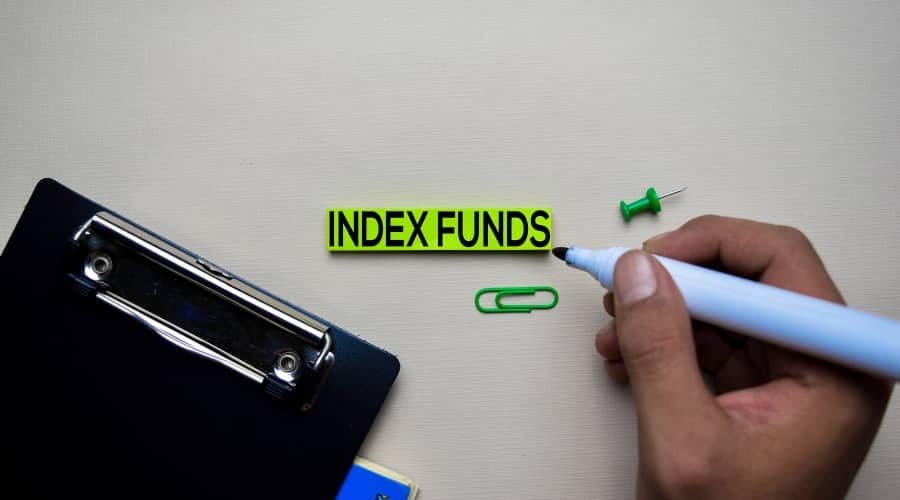A global index tracker fund is the simplest method of investing in a way that exposes you to all of the worlds equity markets at once. This is a common investing choice, particularly for those following a pure ‘index fund’ approach. But is a global index tracker fund a better investment than buying a fund that tracks just the S&P 500?
Investing in a low-cost index fund tracking either the global all-cap index or the S&P 500 index is a good choice for most novice investors. Generally speaking, a fund tracking the S&P 500 is less well-diversified than a global all-cap fund but has historically given higher returns to investors.
So whilst you can’t go too far wrong with either of these investing choices, what can be difficult is deciding which is the best for your personal situation. Have a read of the below post for help answering this question and for other common queries around both S&P 500 and global all-cap tracking funds.
S&P 500 index fund or a Global equities Index Fund?
Index funds that track either the S&P 500 or the global all-cap index are staples of a passive investing philosophy. Funds that track these indexes are well-diversified by definition, avoiding the “all eggs in one basket” trap whilst earning solid average returns historically.
As with all investment decisions (or all decisions generally), you want to consider your risk: reward ratio. The ‘reward’ part of the equation here is clear, what level of returns the fund is able to provide expressed as a % of the capital you contribute + previously accumulated returns.
Risk is harder to determine in a simplistic form but ‘diversification’ is usually considered a key strategy in mitigating risk. Let’s say you had the choice between investing in one successful, profitable mining company which had historically returned 20% per year or you could invest in 3 companies, one in mining, one in technology and one in healthcare which returns an average of 15%.
Which is the optimum choice? Well, clearly the one stock mining company portfolio has earned higher returns historically. Of course, past returns aren’t always an indicator of future returns but this looks to be the best performing Company.
What if government regulations are put in place which makes mining companies less viable? Clearly, this will impact the mining companies stock price and, by extension, your investment. In the three-stock portfolio, this event wouldn’t have such a pervasive impact, it would only hurt one-third of your portfolio rather than the whole thing.
The S&P 500, being an index that tracks the 500 largest companies in the US, obviously brings some baked-in diversification. You have 500 companies, across industries, operating and earning revenue in hundreds of countries.
However, this isn’t perfectly diversified by any means. All the companies are listed in the US and so are subject to the whims of one political system or the words of one president. There’s an argument that the S&P500 is over-weighted in the technology industry due to the performance of big-tech stocks like Facebook, Apple, Amazon and Alphabet.
Here’s where a global all-cap tracker fund comes into play. This index fund aims to track the global equities market by purchasing individual investments representative of the market as a whole. The diversification here goes up another level.
Unlike the S&P 500, the investments are listed around the world so even if one contributing country suffers from political upheaval, it will only impact a set percentage of the overall portfolio. Similarly, no single industry is overweighted because the fund tracks the reality of the overall market.
A truism of stock market investing is that equities increase in value over the long term but fluctuate in value (often dramatically) along the way. It’s for this reason that purchasing an index fund that tracks the global all-cap index is so appealing to so many people. Rather than trying to “beat” the market using expensive fund managers, you can simply jump aboard the market train and benefit from the market returns over time.

What is the S&P 500 and why is it a good investment?
The S&P 500, otherwise known as the Standard & Poors 500 is a stock market index following the performance of the largest 500 publically-traded companies listed on the United States stock exchange. The S&P 500 is seen as an important indicator of the performance of the American stock market as a whole.
For more information on why the S&P 500 is a good investment, check out my recent Guide To Successfully Investing In The S&P 500 For UK Citizens
What is a global index tracker fund and why is it a good investment?
A global index tracker fund is an investment fund aiming to track the performance of the FTSE Global All Cap Index. This index is made up of stocks of varying sizes, industries and geographies aiming to capture the performance of all total investable stocks across the globe.
This index is representative of every publically traded stock across the world and as such is used as an indicator of the condition of the equity market at any given time.
A global index tracker fund is simply an investment vehicle that allows investors to follow the performance of the market as a whole in an affordable way.
Unlike actively managed funds which have the mandate to beat the performance of a given index, an “index fund” or “tracker fund” simply follows the performance of the index as closely as possible.
Historically, very few investors are able to reliably beat the market over the long term so for novice investors who are unable to pour significant time and resources into researching the hottest stocks, investing in index-style funds is usually the optimum choice.
What’s a riskier investment – a global tracker fund or an S&P 500 tracker fund?
In terms of diversification, investing in an S&P 500 tracking fund is riskier than a global all-cap index tracking fund simply because it contains fewer constituent companies and is geographically concentrated in the United States which means it is vulnerable to political or regulatory shifts in that locale.
Intuitively, investing in a fund that tracks all equities seems to be less risky than a fund tracking the 500 largest companies for a few reasons:
- The S&P 500 tracker fund contains only 500 stocks so if one of these stocks were to go to nil following a scandal, that would have approximately a .2% impact on your portfolio value (in reality, it wouldn’t be exactly .2% as the S&P 500 is market capitalisation weighted, meaning more valuable stocks make up a greater share of the overall index).
- The S&P 500 is geographically concentrated in the US, unlike a global-all cap tracker fund which is across the world. That means if the US political class imposed regulation impacting US stocks, the S&P500 would be 100% affected whilst a global world tracker fund would only be impacted by the proportion the US equities make up of total equities.
However, “risk” is a complex term to understand. Whilst the S&P 500 may well be less diversified than a global index tracking fund, it could be argued that investing in an index fund that is likely to perform better will protect you from other risks, like the risk of inflation eating away at the value of your money.
What produces higher returns – the S&P 500 or a global tracker fund?
The S&P 500 index has had an average annualised return of 10.67% which is superior to the annualised average return of the market as a whole. This is due to the biggest companies constituting the S&P 500 tend to contribute the most to the overall growth in equities as an asset class.
One important point to consider is that the S&P 500 is self-cleansing whilst the all-cap index is not. What I mean by this is that the S&P 500, by definition, can only have 500 stocks at any one time. So if one of the 500 stocks tanks, will fall out of the index and be replaced by a different Company.
Due to this, there is a limit to how much damage a poorly performing individual stock can cause to your wider portfolio as if it loses too much value, it will simply be replaced in the index.
The global equities all-cap index, on the other hand, is representative of every stock across the whole equities market so doesn’t have this same self-cleansing effect.
What the global equities all-cap index does have, however, is the potential for a tiny stock to grow in market capitalisation to ultimately be part of the S&P500 and allow investors to benefit from this substantial growth. S&P 500 companies are already at such a level of market capitalisation that the 1 – 1,000,000 style growth seen in smaller cap stocks is not possible.
What is the best global equities tracker fund?
To find a good global equities tracker fund simply sign-up to a reputable, low-cost investing platform and search the list of global funds for reference to ‘all-cap’. The lower the fees (often referred to as TER or OCF) the better. This index fund often has higher fees than an S&P500 tracking fund.
Here are a few good global all-cap equity tracking funds to choose from:
- FTSE Global All Cap Index Fund – Accumulation (Vanguard)
- HSBC FTSE ALL WORLD INDEX (Hargreaves Lansdown)
- Legal & General Global Equity Index Fund (L&G)
What’s better a Vanguard global equity tracker or the Vanguard LifeStrategy fund range?
Investing in either a Vanguard global equity tracker or the Vanguard LifeStrategy fund range are both good choices for novice investors. Both are well-diversified, low-cost, passive investing vehicles that will give investors exposure to a good cross-section of stocks across numerous geographies and industries.
The Vanguard LifeStrategy fund range allows investors to purchase units in a fund that matches their appetite for risk. This range comes in the form of LifeStrategy 20, LifeStrategy40, LifeStrategy60, LifeStrategy80 and LifeStrategy100 whereby the number represents the % of the fund held in equities (stocks). The remainder is held in bonds.
For example, LifeStrategy 60 is 60% equities, 40% bonds. Broadly speaking, bonds are considered a less volatile and lower-risk investment than equities so for both those with a low appetite for risk or those with a short investing horizon (need the money soon) a portfolio higher in bonds is a good idea.
By using the Vanguard LifeStrategy fund range, investors do not have to worry about rebalancing their portfolios to maintain the desired percentage split between equities and bonds as the fund does on investors’ behalf.
Whilst these LifeStrategy funds are often my recommendation to family and friends beginning to invest, there is one downside. The management fees of these funds are much higher (around 0.22%) than could be found in either an S&P500 index fund or a global equity all-cap index fund (0.05-0.15%).
For more information on getting started with investing in index funds on the Vanguard platform, click on the following link to read my post on Start investing into an ISA in the UK with Vanguard: A how to guide

What is the difference between an ETF and an index fund?
Both index funds and ETFs are passively managed investment funds designed to track the performance of certain stocks. The key difference is that ETFs are traded on the open stock exchange so can be traded throughout the day whereas index funds can only be traded at a set point during the day.
An ETF stands for ‘exchange-traded fund’ and is basically a type of fund which passively tracks a group of other equities (stocks). Unlike classic index funds which are traded at a set point in time, ETFs are traded throughout stock-market hours just as a normal stock would be.
In some ways, ETFs give you the best of both worlds in that they are highly liquid and easy to trade like individual stocks but well-diversified and low-cost like index funds.
Is a ‘tracker’ fund the same as an index fund?
A ‘tracker’ fund is the same thing as an ‘index’ fund. Both a tracker fund and an index fund are passive investment funds designed to track an index like the S&P 500 or the FTSE 100. These fund types are typically low-cost as there is not an expensive asset manager to pay who is trying to outperform the index.
How many different index funds should I hold?
It is not necessary to hold multiple different index funds. Once you find an index fund that is low-cost, available on a reputable platform and tracks the index you are interested in, it is perfectly safe to primarily invest in that one fund. Other funds can be used for exposure to different markets.
The idea of investing in numerous different index funds to diversify the risk of a specific fund seems illogical to me. There are optimum index funds to invest in (i.e. those on the best platforms with the lowest ongoing charges) and there are others. To save money on fees, it makes sense to invest as much of your capital in the best funds possible.
As always, please remember I am an Accountant, but not your Accountant. In this post (and all of my others) I share information and oftentimes give anecdotes about what has worked well for me. However, I do not know your personal financial situation and so do not offer individual financial advice. If you are unsure of a particular financial subject, please hire a qualified financial advisor to guide you.
This article has been written by Luke Girling, ACA – a qualified Accountant and personal finance enthusiast in the UK. Please visit my ‘About‘ page for more information. To verify my ACA credentials – please search for my name at the ICAEW member finder. Please comment below or contact me here to get in touch with questions or ideas for future posts.
